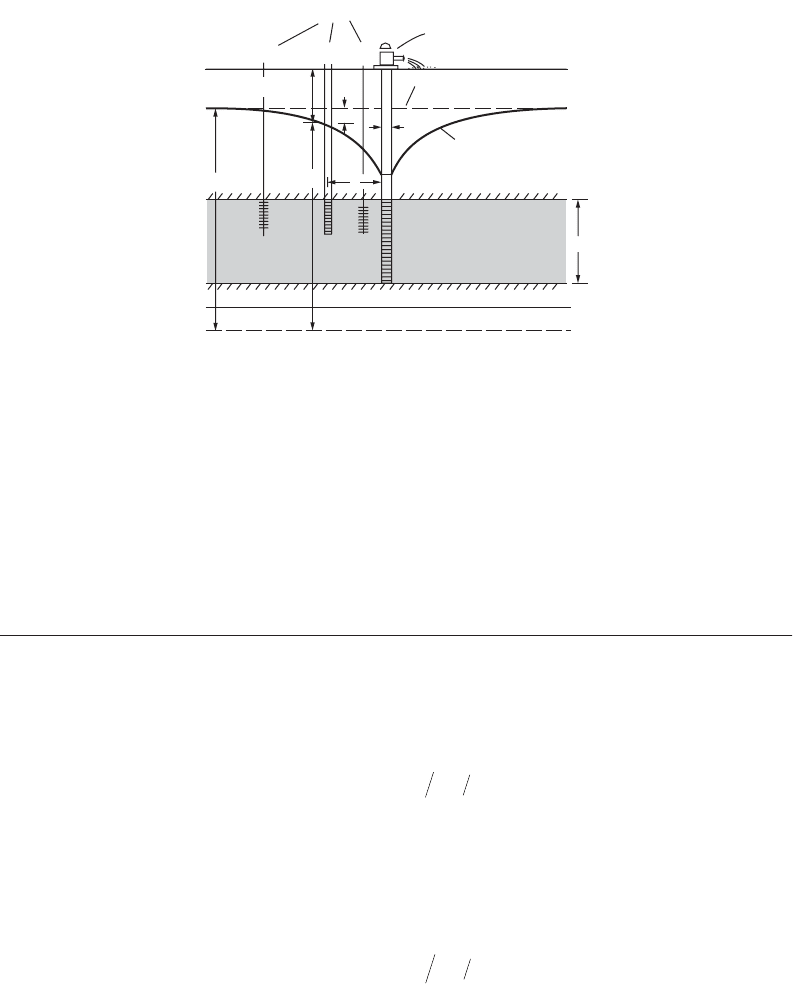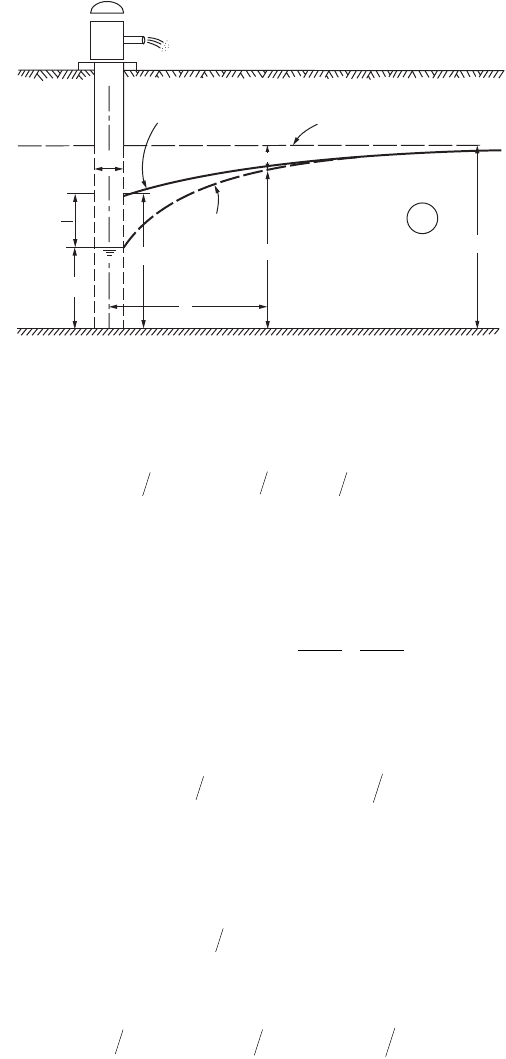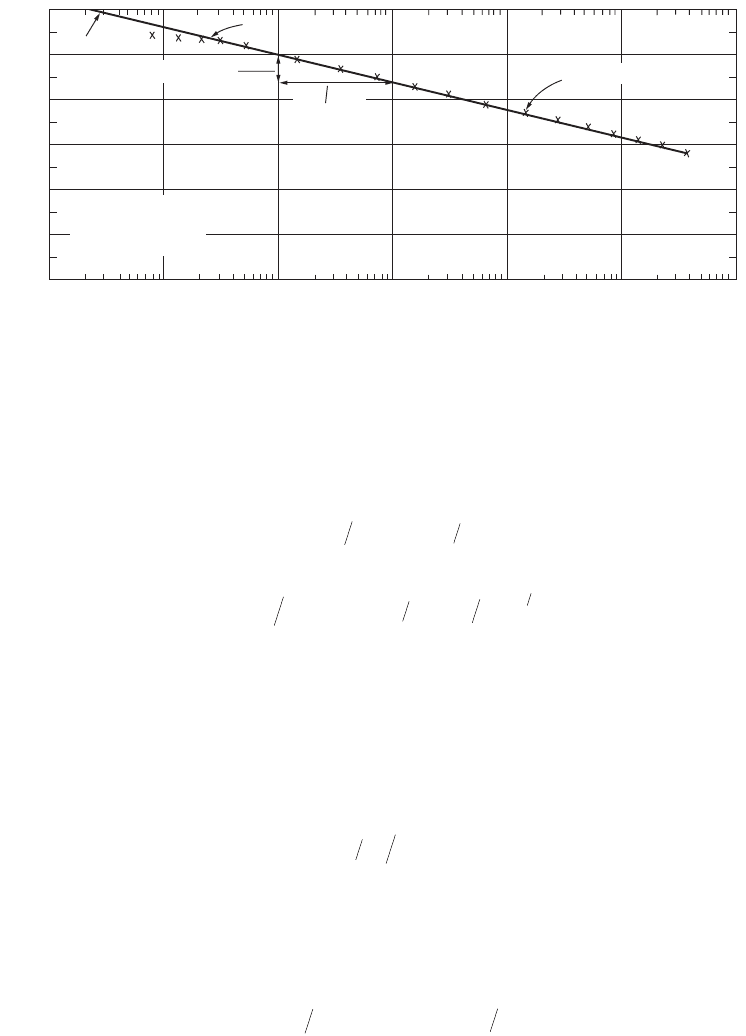Wai-Fah Chen.The Civil Engineering Handbook
Подождите немного. Документ загружается.

Quality of Urban Runoff 33-21
CSO — Combined Sewer Overflow.
CWA — Clean Water Act.
CZARA — Coastal Zone Management and Reauthorization Act.
EPA — Environmental Protection Agency.
Eutrophication — Excess nitrogen and phosphorus caused by over-fertilization. This can lead to algae
blooms and other environmental problems.
Event mean concentration — The average pollutant concentration during the runoff caused by a storm
event.
ISTEA — Intermodal Surface Transportation Efficiency Act.
LT CP — Long-Term Control Plan.
NEP — National Estuary Program.
NMP — National Monitoring Program.
NMC — Nine Minimum Controls.
Nonpoint source — A source of pollution, which is not considered point, generated from stormwater
runoff, agricultural runoff and other sources of runoff.
NPDES — National Pollution Discharge Elimination System.
NURP — Nationwide Urban Runoff Program (EPA, 1983).
Point source — A source of pollution, which is usually traced to a pipe or outfall, such as CSOs, SSOs,
POTWs, etc.
POTW — Publicly Owned Treatment Works.
Sewer infiltration — Flow that enters into the sewer system from underground sources, such as ground-
water.
Sewer inflow — Flow that leaks into the sewer system from various diffuse sources.
SSO — Sanitary Sewer Overflow.
SWMM — Storm Water Management Model.
TMDL — Total Maximum Daily Load.
Urban runoff — All waters generated from urbanization including, but not limited to, stormwater
runoff combined and separate sanitary overflows, and miscellaneous runoff.
Washoff — Amount of pollutant entrained by runoff from urban surfaces.
WQC — Water Quality Criteria.
WQS — Water Quality Standards.
References
Army Corps of Engineers (ACE). 1974. Urban Storm Run-off — STORM, Computer program. The
Hydrologic Engineering Center, Army Corps of Engineers, Davis, CA.
Bhaduri, B., Harbor, J., Engel, B. and Grove, M. 2000. Assessing Watershed-Scale, Long-Term Hydrologic
Impacts of Land-Use Change Using a GIS-NPS Model. Environmental Management, 26(6),
643–658.
Bicknell et al., 1997. Hydrological Simulation Program — Fortran: User’s manual for version 11. Environ-
mental Protection Agency, National Exposure Research Laboratory, Athens, GA. EPA/600/R-97/080.
Cherkauer, D.S. 1975. Urbanization Impact on Water Quality During a Flood in Small Watersheds. Water
Resources Bulletin. 11(5), 987–998.
Delleur, J.W. 1998. Quality of urban runoff, in Hydroinformatics Tools for Planning, Design Operation and
Rehabilitation of Sewer Systems, Marsalek, J. et al., Eds., Kluwer Academic Publishers, Dordrecht,
The Netherlands, pp. 241–286.
Environmental Protection Agency. 1971. Stormwater Management Model. EPA 11024D0OC 07/71 to
1102DOC 10/71. Washington, D.C.
Environmental Protection Agency. 1978. Report to Congress on Control of Combined Sewer Overflow
in the U.S. EPA 430/9–78–006. Washington, D.C.
© 2003 by CRC Press LLC
33-22 The Civil Engineering Handbook, Second Edition
Environmental Protection Agency. 1983. Results of the Nationwide Urban Runoff Program. Final Report.
NTIS Accession No. PB 84–185552.
Environmental Protection Agency. 1986. Quality Criteria for Water (Gold Book). Office of Water. EPA
440/5–86–001. Washington, D.C.
Environmental Protection Agency. 1991. Amendments to the Water Standards Regulation. Federal Reg-
ister. Vol. 56, No. 223.
Environmental Protection Agency. 1994. Combined Sewer Overflow Control Policy 59. Federal Register
18688.
Environmental Protection Agency. 1995a. Guidance for Long-Term Control Plan for Combined Sewer
Overflows. Report EPA 832-B-95–002.
Environmental Protection Agency. 1995b. Guidance for Nine Minimum Controls for Combined Sewer
Overflows. Report EPA 832-B-95–003.
Environmental Protection Agency. 1996. National Water Quality Inventory. Washington, D.C.
Environmental Protection Agency. 1997a. Nonpoint Pointers Series. Report EPA 841-F-96–004,
www.epa.gov/owow/NPS/facts.
Environmental Protection Agency. 1997b. Technical Guidance for Developing Total Maximum Daily
Loads. Book 2: Streams and Rivers. EPA 823-B-97–002.
Environmental Protection Agency. 1999a. Guidance for Monitoring and Modeling for Combined Sewer
Overflows. Report EPA 832-B-99–002.
Environmental Protection Agency. 1999b. Stormwater Treatment at Critical Areas: The Multi-Chambered
Treatment Train (MCTT). EPA/600/R-99/017.
Environmental Protection Agency. 2000a. National Conference on Tools for Urban Water Resource
Management and Protection. Proceedings, February 7–10, 2000. Chicago, IL. EPA/625/R-00/001.
Environmental Protection Agency. 2000b. Nonpoint Source News (Issue #63). Office of Water.
Environmental Protection Agency. 2000c. Total Maximum Daily Load Program. Office of Water.
www.epa.gov/owow/tmdl.
Environmental Protection Agency. 2000d. Storm Water Phase II Final Rule. Report EPA 833-F-00-001.
Environmental Protection Agency. 2001a. EPA’s CSO Control Policy. Office of Water. www.epa.gov/owm/cso.
Environmental Protection Agency. 2001b. Guidance: Coordinating CSO Long-Term Planning with Water
Quality Standards Reviews. Report EPA 833-R-01–002.
Environmental Protection Agency. 2001c. Sanitary Sewer Overflows. Office of Water. www.epa.gov/owm/sso.
Harremoës, P. and Rauch, W. 1996. Integrated Design and Analysis of Drainage Systems, Including Sewers,
Treatment Plant and Receiving Waters, J. Hydraulic Res., 34, 6, 815–836.
Hobbs, D.V., Tor, E.V. and Shelton, R.D. 1999. Equalizing Wet Weather Flows. Civil Engineering. ASCE,
69(1), 56–59.
Houck, O.A. December 1995. The Clean Water Act – TMDL Program: Law, Policy, and Implementation.
Environmental Law Institute. Washington, D.C.
Huber, W.C. and Dickinson, R.E. 1988. Storm Water Management Model, Version 4: User’s Manual.
Environmental Protection Agency, Athens, GA. Report No. EPA/600/3-88-001a.
Krejci, V., Krebs, P., and Schilling, W. 1998. Integrated Urban Drainage Management, Hydroinformatics
Tools for Planning, Design Operation and Rehabilitation of Sewer Systems, Marsalek, J. et al. (Eds.),
Kluwer Academic Publishers, Dordrecht, The Netherlands.
Marsalek, J., Maksimovic, C., Zeman, E., and Price, R. (Eds.) 1998. Hydroinformatics Tools for Planning,
Design Operation and Rehabilitation of Sewer Systems, Kluwer Academic Publishers, Dordrecht,
The Netherlands.
Mays, L.W. (Ed.) 2001. Stormwater Collection Systems Design Handbook, McGraw-Hill, New York, NY.
Mealey, M. The CSO Controversy. Civil Engineering. September 1999.
MOUSE. 1992. Modeling of Urban Sewer System on Microcomputers, User’s Guide, Danish Hydraulic
Institute.
Novotny, V. and Chesters, G. 1981. Handbook of Nonpoint Pollution, Sources and Management, Van Nostrand
Reinhold, New York.
© 2003 by CRC Press LLC
Quality of Urban Runoff 33-23
Novotny, V. and Olem, H. 1994. Water Quality: Prevention, Identification, and Management of Diffuse
Pollution. Van Nostrand Reinhold, New York.
Pitt, R. and Field, R. 1977. Water Quality Effects From Urban Runoff. American Water Works Association.
69:432–436.
Schueler, T.R. 1994. Watershed Protection Techniques: A Quarterly Bulletin On Urban Watershed Res-
toration and Protection and Protection Tools. Center for Watershed Protection, 1, 1.
URS Urban Drainage and Flood Control District, Urban Water Resources Research Council (UWRRC)
of ASCE and EPA. July 1999. Determining Urban Stormwater Best Management Practice (BMP)
Removal Efficiencies.
U.S. Congress. 1987. Water Quality Act of 1987. P.L. 100–4. Washington, D.C.
Walesh, S.G. 1989. Urban Surface Water Management. John Wiley & Sons, New York.
Water Environment Federation. 1989. Combined Sewer Overflow Pollution Abatement. Manual of Practice
FD-17.
Water Environment Federation (WEF) and American Society of Civil Engineers (ASCE). 1998. Urban
Runoff Quality Management. WEF Manual of Practice No. 23. WEF, Alexandria, VA.
Further Information
The EPA Website (www.epa.gov/owow) has additional information on CSOs, SSOs, point and nonpoint
source pollution, regulations, NPDES program, TMDL Program, NURP, BMPs and other related
topics.
Houck, O.A. December 1995. The Clean Water Act — TMDL Program: Law, Policy, and Implementation.
Environmental Law Institute. Washington, D.C. This provides a good review of the TMDL program
from a policy perspective.
Marsalek, J. et al. 1998. Hydroinformatics Tools for Planning, Design, Operation and Rehabilitation of Sewer
Systems. Kluwer Academic Publishers, Dordrecht, The Netherlands (NATO, ASI Series). This NATO
Advanced Studies Institute (ASI) book provides in-depth treatment of urban environmental mod-
els, model data needs and management, modeling of urban runoff quality and quality in sewer
networks, operation and rehabilitation of sewer networks and integrated urban water management.
European practices are discussed.
Mays, L.W. (Ed.). 2001. Stormwater Collection Systems Design Handbook. McGraw Hill, New York.
Chapter 18 provides information on flow control and regulators used in storm and combined sewer
overflow. Chapter 19 reviews the removal of urban pollution from stormwater systems.
© 2003 by CRC Press LLC

© 2003 by CRC Press LLC
34
Groundwater
Engineering
34.1 Fundamentals
Introduction • Subsurface Water • Physical Properties • Darcy’s
Law • Dupuit Assumption
34.2 Hydraulics of Wells
Steady Flow to a Well • Transient Flow to a Well • Pumping
Tests • Multiple Wells and Boundaries
34.3 Well Design and Construction
We ll Design • Construction Methods
34.4 Land Subsidence
Introduction • Calculation of Subsidence
34.5 Contaminant Transport
Introduction • Advection • Diffusion and Dispersion •
Sorption • Multiphase Flow
34.6 Remediation
Monitoring Wells • Removal and Containment of
Contaminants • Wellhead Protection
34.7 Landfills
Software
34.8 Geostatistics
Definition of Kriging • Stationary and Intrinsic Cases •
Estimation • Extension and Software
34.9 Groundwater Modeling
Software
34.1 Fundamentals
Introduction
This chapter on groundwater engineering is concerned with the occurrence, movement, use and quality
of water below ground. The section on fundamentals deals with the definitions, the properties of the
unsaturated and saturated zones, and the physics of the movement of subsurface water. Specific engi-
neering applications such as well hydraulics, well construction, contaminant transport, containment of
contaminants, landfills, and geostatistics are discussed in the following sections.
Subsurface Water
The
water table
is the level at which the groundwater is at atmospheric pressure. The zone between the
ground surface and the water table is called the
vadose zone
.
It contains some water that is held between
J. W. Delleur
Purdue University

34
-2
The Civil Engineering Handbook, Second Edition
the soil particles by capillary forces. Immediately above the water table is the capillary fringe where the
water fills the pores. The zone above the capillary fringe is often called the
unsaturated zone . Below the
capillary fringe is the
saturated zone . The saturation ratio is the fraction of the volume of voids occupied
by water. The water above the water table is below atmospheric pressure while the water below the water
table is above atmospheric pressure. Only the water below the water table, the
groundwater
, is available
to supply wells and springs. Recharge of the groundwater occurs primarily by percolation through the
unsaturated zone. The geologic formations that yield water in usable quantities, to a well or a spring,
are called
aquifers . If the upper surface of the saturated zone in the aquifer is free to rise or to decline
the aquifer is said to be an
unconfined aquifer . The upper boundary at atmospheric pressure is the water
table, also called the
phreatic surface . If the water completely fills the formation the aquifer is
confined
and the saturated zone is the thickness of the aquifer. If the confining material is impermeable it is called
an
aquiclude . If the confining layer is somewhat permeable in the vertical direction, thus permitting
slow recharge, it is called an
aquitard . When a layer restricts downward infiltration towards the main
water table, a
perched aquifer with a separate perched water table may be formed. A perched aquifer is,
in general, of limited areal extent, and if used as a water supply, extreme caution should be exerted
because of its ephemeral nature. If the water in a well in a confined aquifer rises above the top of the
aquifer, the water in the aquifer is under pressure, the well is called an
artesian well
, and the aquifer is
in artesian condition. The
potentiometric
surface,
also called the piezometric surface is defined as , the
surface connecting the levels to which water will rise in several wells. If the piezometric surface is above
the ground surface then a flowing well results.
Physical Properties
The porosity
,
n,
is the ratio of the volume of voids,
V
v
, to the total volume,
V
t
, of the rock or soil:
where
V
s
is the volume of solids.
The
void ratio
,
e
, used in soil mechanics, is defined as
e
=
V
v
/
V
s
so that 1/
n
= 1 + 1/
e
. The fraction of
void space between grains of soil or of unconsolidated rock is referred to as
primary porosity
. Porosity
due to fracturing of the rock or chemical dissolution is called
secondary porosity
. Ty pical values of the
porosity are given in the following Table 34.1. The
effective porosity
,
n
e
, is the pore fraction that actually
contributes to the flow, isolated and dead end pores are excluded. In unconsolidated sediments coarser
than 50
m
m,
n
e
is of the order of 0.95
n
to 0.98
n
. When all the voids are occupied by water the soil is
TABLE
34.1
Values of Porosity, Permeability, and Hydraulic Conductivity
Material
Porosity
n (
%
)
Permeability
k cm
2
Hydraulic
conductivity
K cm
/
s
Unconsolidated deposit
Gravel
Sand
Silt
Clay
Rocks
Fractured basalt
Karst limestone
Sandstone
Limestone, dolomite
Shale
Fractured crystalline rock
Dense crystalline rock
25–40
25–50
35–50
40–70
5–50
5–50
5–30
0–20
0–10
0–10
0–5
10
–3
–10
–6
10
–5
–10
–9
10
–8
–10
–12
10
–12
–10
–15
10
7
–10
–11
10
–5
–10
–9
10
–9
–10
–13
10
–9
–10
–12
10
–12
–10
–16
10
–7
–10
–11
10
–13
–10
–17
10
2
–10
–1
1–10
–4
10
–4
–10
–7
10
–7
–10
–10
10
–2
–10
–6
1–10
–4
10
–4
–10
–8
10
–4
–10
–7
10
–7
–10
–11
10
–2
–10
–6
10
–8
–10
–12
nVV V VV
vt t s t
==-
[]
© 2003 by CRC Press LLC

Groundwater Engineering
34
-3
saturated. Otherwise the fraction of the voids occupied by water is the volumetric water content designated
by q, which is dimensionless. When the soil is saturated, the soil moisture content is q
s
= n. After the
soil has been drained the remaining soil moisture is the residual moisture content q
r
. In unsaturated soils
the effective porosity is q
e
= n – q
r
and the effective saturation is defined as
The hydraulic conductivity, K, is a measure of the ability of water to flow through a porous medium.
It is the volume rate of flow, Q, per unit gross area, A, of soil or rock under a hydraulic gradient ∂h/∂s:
For saturated flows the hydraulic conductivity, K, depends on the porous medium through the intrinsic
permeability, k, and on the fluid properties through the density, r, and the viscosity, m. These properties
are related by the following equation
so that a usual expression for k is
For spheres k = C d
2
, where C is a constant, k has the dimension of L
2
and K has the units of L/T.
–1
Ranges of values of the permeability and hydraulic conductivity are given in Table 34.1. Several formulas
exist in the literature that estimate the hydraulic conductivity of granular noncohesive materials. Most
are of the form
where g = the acceleration of gravity
n = the kinematic viscosity
C =a coefficient
f(n) = a function of the porosity
d
e
= the effective grain diameter, with the variables in a consistent set of units.
Vukovic and Soro (1992) list 10 formulas of this type. Two of the simplest formulas are the Hazen
formula with C = 6 ¥ 10
–4
, f(n) = [1 + 10(n – 0.26)], d
e
= d
10
which is applicable for 0.1 mm < d
e
<
3 mm and d
60
/d
10
< 5 and the USBR formula with C = 4.8 ¥ 10
–4
d
20
0.3
, f(n) = 1, d
e
= d
20
and is applicable
to medium sand grains with d
60
/d
10
<5 where d
10
is the particle size such that 10% are finer.
When the flow occurs horizontally through a series of n equally thick layers in parallel, of hydraulic
conductivities K
1
, K
2
,…,K
n
, the equivalent hydraulic conductivity of the system of layers is the arithmetic
average of the conductivities. When the flows occurs vertically through a stack of n equal layers in series,
the equivalent hydraulic conductivity of the system of layers is the harmonic mean of the conductivities
For an anisotropic material with horizontal and vertical hydraulic conductivities K
x
and K
y
, respectively,
the hydraulic conductivity at an angle a with the horizontal, K
a
, is obtained from
sn
err
=-
()
-
()
qq q
KQAhs=-
()
∂∂
()
-1
Kkg=r m
kQA ghs=-
()( )
∂∂
()
-
mr
1
KgCnd
e
=
()
()
nf
2
K
n
KK K
n
=
+++
11 1
12
L
© 2003 by CRC Press LLC

34-4 The Civil Engineering Handbook, Second Edition
For an unsaturated condition the hydraulic conductivity is a function of the moisture content of the
soil and is designated by K(q). When the soil is saturated the saturated hydraulic conductivity is designated
by K
s
. The ratio of the hydraulic conductivity for a given moisture content to the saturated conductivity
is the relative conductivity, K
r
. Brooks and Corey (1964) gave the following formula for the hydraulic
conductivity of unsaturated porous materials
where l is an experimentally obtained coefficient.
Other formulas have been given by Campbell (1974) and van Genuchten (1980).
The transmissivity, T, is the product of the hydraulic conductivity and the thickness, b, of the aquifer:
T = K b. It has the units of L
2
T.
–1
The storage coefficient, or storativity, S, is the volume of water yielded
per unit area per unit drop of the piezometric surface. For unconfined aquifers the drop of the water
table corresponds to a drainage of the pore space and the storage coefficient is also called the specific
yield. In an unconfined aquifer the amount of water that can be stored per unit rise of the water table
per unit area is called the fillable porosity, f, where f = q
s
– q. In a confined aquifer, when the water
pressure decreases the fluid expands and the fraction of the weight to be carried by the solid matrix
increases, resulting in a decrease of the pore space. Since the compressibility of the water is very small
its decompression contributes only a small fraction to the storage coefficient. The leakage of an overlying
unconfined aquifer through an aquitard can also contribute to the yield of a semi-confined aquifer. Values
of S typically vary between 5 ¥ 10
–2
and 10
–5
for
confined aquifers.
Darcy’s Law
The volumetric flow rate Q [L
3
T
–1
] across a gross area A of a formation with a hydraulic conductivity K
[LT
–1
] under a hydraulic gradient ∂h/∂s in the s direction is given by Darcy’s law
where q is the specific discharge or flow rate per unit area [LT
–1
] also called Darcy velocity. The hydraulic
head h is the sum of the elevation head z and the pressure head p/g. The minus sign in the above equation
indicates that the flow takes place from high to low head, namely in the direction of the decreasing head.
The pore velocity, v = q/n
e
, is the average flow velocity in the pores or the average velocity of transport
of solutes that are non reactive.
The one-dimensional form of Darcy’s law in a homogeneous medium of conductivity K is
where the subscripts 1 and 2 refer to the two points at which the pressure head and the elevation head
are considered and L is the distance between these points.
Darcy’s law implies that the flow is laminar as is generally the case. However in some cases, as in karstic
limestone and in rocks with large fractures, the flow may be turbulent. In such cases the flow rate is not
proportional to the hydraulic gradient but to a power of the hydraulic gradient. Darcy’s law as given above
applies to isotropic media, that is, where the hydraulic conductivity is independent of direction. It also
applies to flows where the direction of the hydraulic conductivity corresponds to the direction of the
hydraulic gradient. In non isotropic media the hydraulic conductivity depends upon the direction. Then
a hydraulic conductivity tensor is used and Darcy’s law is expressed as a tensor equation (de Marsily, 1986).
1
22
KK K
xya
aa
=+
cos sin
KK n
sr r
qqqq
l
()
=-
()
-
()
[]
QKAhsqA=- ∂∂=
qKp z p z L=+
()
-+
()
[]
112 2
gg
© 2003 by CRC Press LLC

Groundwater Engineering 34-5
Dupuit Assumption
The one-dimensional form of Darcy’s law applies to simple flow problems in the vertical or horizontal
direction. In some cases with both horizontal and vertical components, the horizontal component
dominates and the vertical component can be neglected. The flow can then be approximated as a
horizontal flow uniform across the depth. This is the Dupuit assumption also sometimes referred to as
the Dupuit-Forchheimer assumption.
34.2 Hydraulics of Wells
Steady Flow to a Well
The steady flow to a well of radius r
w
fully penetrating a confined aquifer (Fig. 34.1) with a transmissivity
T is given by the Thiem equation
where h = the hydraulic head at a distance r
h
w
= the hydraulic head at the well
For a well fully penetrating an unconfined aquifer (Fig. 34.2) the equation for the flow rate obtained
using the Dupuit assumption and neglecting the seepage face is:
When solved for the head at the well, this equation does not yield accurate results because of the
neglect of the vertical flow component.
Transient Flow to a Well
Pumping a well causes a cone of depression, or drawdown, of the water table of an unconfined aquifer or
of the piezometric surface for a confined aquifer. The drawdown s(r,t) at a distance r from a fully
penetrating well at time t after the beginning of pumping at a constant rate Q from a confined aquifer
with transmissivity T and storage constant S is given by the Theis equation:
FIGURE 34.1 Well in a confined aquifer. (Source: Heath, R.C. 1998. Basic Ground-Water Hydrology. U.S. Geological
Survey Water Supply Paper 2220, U.S. Government Printing Office.)
CBA
Observation wells
Pumping well
Pumping water level
Static water level
Confining bed
Confining bed
Confined aquifer
Datum plane
r
h
s
h
0
Depth to water
2r
w
b
QThh rr
ww
=-
[]
()
2p ln
QKhh rr
ww
=-
[]
()
p
22
ln
© 2003 by CRC Press LLC

34-6 The Civil Engineering Handbook, Second Edition
where u = r
2
S/(4Tt).
The integral in this equation is the exponential integral also known as the well function W(u). This
function can be expanded as
For u < 0.01 only the first two terms need to be considered and the drawdown is approximated by
Jacob’s equation
The drawdown from a unconfined aquifer with horizontal and vertical hydraulic conductivities K
r
and
K
z
, respectively, has been given by Neuman (1975). A simplified form, given by Freeze and Cherry (1979),
is
where
where b = the initial saturated thickness
S
y
= the specific yield
S = the elastic storage coefficient
This solution is valid for S
y
S. Freeze and Cherry (1979) give a plot of the well function W(u
a
, u
b
, h).
FIGURE 34.2 We ll in a unconfined aquifer. (Source: Bouwer, H., 1978. Ground Water Hydrology. McGraw-Hill, New
Yo r k.)
Water table
(Dupuit
assumption)
Pumping well
Tr ue water table
Static water level
Seepage
surface
Confining bed
r
h
s
H
K
2r
w
h
w
h
iw
srt Q T e z dz Q T Wu
z
u
,
()
=
()
[]
()
=
()
[]
()
-
•
Ú
44pp
Wu u u
uu
()
=- - + -
¥
+
¥
-0 577216
22 33
23
.ln
!!
L
srt Q T Tt rS,. log .
()
=
()
[]
()
()
[]
230 4 225
10
2
p
srt Q T Wu u
ab
,,,
()
=
()
[]
()
4ph
urSTt urS Tt rKbK
aby zr
=
()
=
()
=
()
2222
44, ,h
© 2003 by CRC Press LLC

Groundwater Engineering 34-7
For a pumped leaky confined aquifer with constants T and S, separated from an unpumped upper
aquifer by an aquitard of thickness b¢ and constants K¢ and S¢, Hantush and Jacob (1955) obtained a
relationship for the drawdown which can be written as
where
Values of W (u, r/B) can be found in Bouwer (1978), Freeze and Cherry (1979) and Fetter (2001).
Pumping Tests
The hydraulic properties of aquifers can be determined by pumping a well at constant discharge and
observing the drawdown at one or more observation wells for a period of time. For confined aquifers
the Thiem steady state equation yields only the transmissivity
from the observed drawdowns s
1
and s
2
at distances r
1
and r
2
from the pumped well.
For confined aquifers the transient state Jacobs equation yields both the transmissivity and the storage
constant based on a semi-log straight line plot (Fig. 34.3) of the observed drawdown (arithmetic scale)
versus the time since pumping began (logarithmic scale) as
where Ds = the increase in drawdown per log cycle of t
t
o
= the time intercept of the straight line fitted through the drawdowns at the several times.
Only the observations corresponding to very small times violate Jacobs assumption that u = r
2
S/(4Tt) <
0.01 and do not fall on the straight line. This approach is known as time-drawdown analysis. If simulta-
neous drawdown observations are taken at different distances, then the distance drawdown analysis can
FIGURE 34.3 Time drawdown analysis (Source: Heath, R.C., 1998. Basic Ground-Water Hydrology.U.S. Geological
Survey, Water Supply Paper 2220, U.S. Government Printing Office.)
0
2
4
6
8
10
12
10
−5
10
−3
10
−2
0.1 1 1010
−4
Time (in days)
Drawdown (s), (in meters)
Log cycle
∆s = 1.2 m
r = 75 m
Q = 9.3 m
3
/min
t
0
= 2.5 × 10
−5
d
t
0
t
c
Drawdown measurements
srt Q T W u r B,,
()
=
()
[]
()
4
urS Tt rBrKTb=
()
()
=
¢¢
()
[]
2
12
4 and
TQ rr ss=
()
[]
-
()
[]
ln
21 1 2
2p
TQ sS Ttr
o
=
()
=23 4 225
2
. .pD
© 2003 by CRC Press LLC
